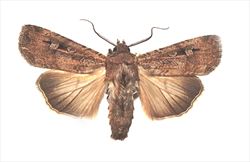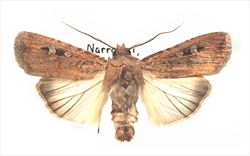OF BIOSECURITY CONCERN
Noctuoidea
Noctuidae (armyworms, cutworms, semi-loopers) 11,772 approximate described species
Subfamilies with target pests: Hadeninae, Noctuinae, Heliothinae, Plusiinae
Cosmopolitan particularly in the tropics.
Sugarcane, cotton, maize, sorghum, rice, grapes, Cucurbitaceae, Gramineae, Brassica, Solanum
The subfamilies can be divided into two groups based on wing venation: the trifines and quadrifines. It is unknown whether this family is monophyletic, with the ultimate composition of this family still being debated. There is no suprageneric classification available for Noctuoidea. Identification must begin at the species level.
Hadeninae – trifine venation; hairy eyes
Noctuinae – trifine venation; Agrotis sp. bipectinate antennae ♂; filiform ♀; forewing narrower than hindwing; 2 or 4 spurs on hind tibia with spines
Heliothinae – trifine venation - No easy way to distinguish this subfamily
Plusiinae – Trichoplusia sp. quadrified venation; shiny or silvery markings; ♂ scale tufts on abdomen; orange pencil hairs
Atlas of Living Australia. National Research Infrastructure for Australia, NCRIS. http://www.ala.org.au/
ABRS 2009. Australian Faunal Directory. Australian Biological Resources Study, Canberra. http://www.environment.gov.au/biodiversity/abrs/online-resources/fauna/afd/index.html
Barlow HS (1982) An introduction to the Moths of South East Asia, The Malayan Nature Society, Kuala Lumpur.
Butterflies and moths of North America, collecting and sharing data about Lepidoptera. National Biological Information Infrastructure (NBII) Program and the USGS Northern Prairie Wildlife Research Center. http://butterfliesofamerica.com/links.htm
CSIRO Australian National Insect Collection Database. http://anic.ento.csiro.au/database/
CSIRO Ecosystem Sciences. Australian Moths Online. http://www1.ala.org.au/gallery2/main.php
Herbison-Evans D, Crossley S. Families of Moths in Australia. http://lepidoptera.butterflyhouse.com.au/moths.html
Holloway JD, Kibby G, Djunijanti P (2001) The families of Malesian moths and butterflies, Fauna Malesiana handbook 3, The Netherlands.
iBol Terrestrial Biosurveillance, Lepidoptera barcode of life. http://www.lepbarcoding.org/
Natural History Museum, The Global Lepidoptera Names Index. http://www.nhm.ac.uk/research-curation/research/projects/lepindex/search/index.dsml
Plant Health Australia (2012) Combined High Priority Pest List from Industry Biosecurity Plans. In National Plant Biosecurity Status Report, last accessed June 2015. http://www.planthealthaustralia.com.au/biosecurity/emergency-plant-pests/pest-categorisation/categorised-pests/
Polaszek A (1998) African cereal stem borers: economic importance, taxonomy, natural enemies and control. Wallingford, UK.
The Barcode of Life Data Systems http://www.boldsystems.org/
Common IFB (1990) Moths of Australia, p 445. Melbourne University Press, Carlton, Victoria.
Kristensen NP (ed) (1999) Lepidoptera, Moths and Butterflies: Evolution, Systematics and Biogeography (vol. 1). Handbook of Zoology, Walter de Gruyter, Berlin.
Matthews M (1999) Heliothine Moths of Australia, a guide to pest bollworms and related Noctuid groups. Monographs on Australian Lepidoptera (vol. 7) CSIRO Publishing, Victoria, Australia
Northern Australia Quarantine Strategy (2015) Entomology Internal Target List. Australian Government Department of Agriculture.
Operational Science Program (2015) Entomology Internal Target List. Australian Government Department of Agriculture.
Plant Health Australia (2012) Combined High Priority Pest List from Industry Biosecurity Plans. In National Plant Biosecurity Status Report, last accessed June 2015. http://www.planthealthaustralia.com.au/biosecurity/emergency-plant-pests/pest-categorisation/categorised-pests/
van Nieukerken EJ, Kaila L, Kitching IJ, Kristensen NP, Lees DC, et al. (2011) Order Lepidoptera Linnaeus, 1758. In Zhang, Z.-Q. (Ed.) Animal Biodiversity: An outline of higher level classification and survey of taxonomic richness. Order Lepidoptera Linnaeus, 1758. Zootaxa. 3148: 212–221.




